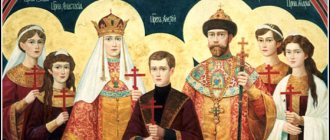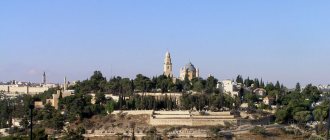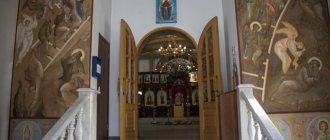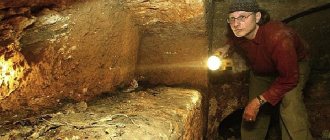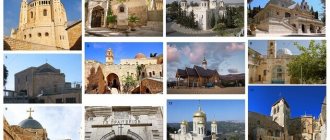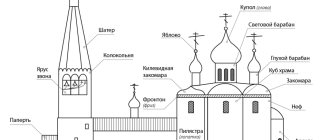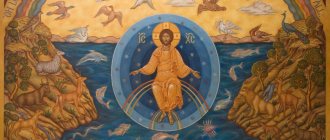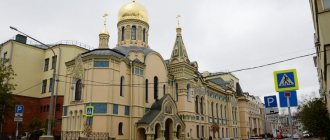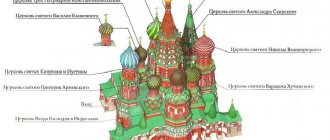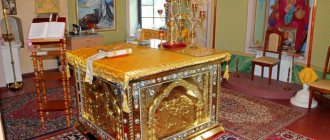Lambert Dolphin and Michael Kollen (by Lambert Dolphin and Michael Kollen)
Translation © — 2009
For our sins we were expelled from our country and excommunicated from our land.
We cannot ascend as pilgrims to pray to You, to fulfill our duties in Your chosen house, the great and holy Temple, which was called by Your name, because of the hand that was released on Your shrine. Thy will be done, O Lord our God and God of our fathers, merciful Lord, in Thy abundant love show mercy again to us and Thy sanctuary; may it be restored soon and may its glory increase. (From a Jewish prayer). [td]
| View of the Temple Mount looking southeast. |
Below the pavement level at the top left of the photo are rooms known as Solomon's Stables, traditionally dating from Herod's expansion of the Temple Mount. At the top right is the gray dome of the Al-Aqsa Mosque. Near the right edge of the photo is the Western Wall (Kotel), the place where Jews pray. The Dome of the Rock is especially beautiful with the recent addition of a new gold plating to the anodized aluminum dome. The traditional location of the First and Second Temples is assumed to be in close proximity to the Dome of the Rock. The supposed "northern" position of the Temple is immediately to the left of the steps in the lower left corner of the photo. The "southern" location of the Temple is midway between the Dome of the Rock and the Al-Aqsa Mosque, under the Muslim ablution fountain known as El Kas. The base level of Mount Moriah surfaces inside the Dome of the Rock and is located directly below the pavement stones of the surrounding area. However, to the south the base descends in steps towards the City of David and the Hinnom Junction and Kidron Valleys.
Temple Mount: location of the Jewish Temples.
The Temple Mount in the Old City of Jerusalem today occupies an area of approximately 45 acres. It is surrounded by a trapezoidal wall: the south wall is about 910 feet long, the north wall is about 1025 feet, the east wall is about 1520 feet, and the west wall is about 1580 feet long. The average height of the site above sea level is about 2400 feet. Most of the buildings and ground structures are Muslim - to date, no visible traces of the First or Second Temples can be found on the site. The territory is developed like a park - trees and shrubs are planted, many ancient buildings and monuments that arose over the last 1300 years of Muslim control over this place.
Today, the Temple Mount site is topographically located just below the top of the ridge system known as Mount Moriah. At the end of his reign, David acquired this place from a Jebusite named Aravna (Orna). King David developed this area in order to build a permanent “House of God” there to replace the Tabernacle of Moses, which followed with the Jews after the Exodus from Egypt to the Promised Land. David had plans drawn up to build a Tabernacle twice the size, and he prepared large quantities of building materials: stone, cedar, and much gold and silver. However, only Solomon, his son, actually built the First Temple (1 Chronicles 22:14-15, 28:11-20).
The hill system where the Temple Mount now sits is recognized by many credible sources as the site where Abraham was told to sacrifice Isaac (Genesis 22:1-2). Since Solomon built the First Temple about 3,000 years ago, Abraham was on Mount Moriah about a thousand years earlier.
HOLY OF HOLIES
Both the First and Second Jewish Temples were built on the model of the Tabernacle - the marching temple of the Jews (originally a tent, tent).
The construction of the permanent stone Temple of Solomon, which shocked the East with its splendor, became possible during the Golden Age of the Jews, shortly after they occupied Jerusalem in 1000 BC. and the formation of the Kingdom of Israel. King David (reigned 1005-965 BC) bought the mountain and began preparatory work on the project: he collected a considerable part of the funds, developed a detailed plan for the building, extensions and three courtyards surrounding the temple, and bequeathed the construction work to his son Solomon. Huge funds were spent on the construction, including generous gifts from the biblical Queen of Sheba (from Arabian Shaba. Solomon was a good administrator, diplomat, builder, industrialist (built a copper smelting enterprise near the Wadi al-Arab valley mine) and trader (in particular, was engaged in intermediary trade in horses and chariots between Egypt and Asia, equipped expeditions for gold and incense to the legendary country of Ophir / Punt).According to legend, King Solomon (reigned 965-928 BC) began construction of the Jerusalem Temple in the fourth year of his reign, in 480 after the Exodus of the Jews from Egypt.Construction of the temple lasted 7 years: from 967 to 960 BC.The temple dominated all surrounding buildings, including the royal ceremonial palace, the summer palace and the palace of the daughter of the Egyptian pharaoh, whom Solomon took as his wife. The entire palace and temple complex took 16 years to build. After the fall of the Northern Kingdom of Israel and the destruction by the Assyrians of the temples in Dan and Bethel, the Jerusalem Temple turned into the central sanctuary of all Israelite tribes, and after the liquidation of pagan cults in 662 it acquired the status of the main national-religious center.
Reconstruction of Solomon's Temple.
The temple building was surrounded by three courtyards. Adjacent to the temple, surrounded by a low fence that allowed the people to see the sacred rites, was the Courtyard of the Priests with a copper altar in the form of a blossoming lily on twelve oxen. Behind the fence was the People's Courtyard. Behind it is the Court of the Pagans, surrounded by a stone wall with four entrances. Presumably the royal place was located there. The main part of Solomon's temple was the Sanctuary and the Holy of Holies (a cubic space 5 m below the Sanctuary, which formed a room for storing sacred things. The Sanctuary was illuminated by a lamp that burned day and night, and the Holy of Holies received light only during services through the open doors. In the Sanctuary there was a golden incense altar, ten lamps and ten tables of offering. The Holy of Holies contained the Ark of the Covenant - the main shrine of the Jews, with the stone Tablets of the Law received by Moses from God on Mount Sinai. Initially, other sacred relics were kept there - Aaron's rod and cups with manna, but by that time they had already been lost. The Ark itself was lost during the complete destruction of the first Temple of Jerusalem by the Babylonian king Nebuchadnezzar in 586 BC. Jerusalem was burned, its walls were torn down, the inhabitants who survived the siege were driven into slavery...
Plan of Solomon's Temple.
Consecrated Ground
According to rabbinic sources, both the First and Second Temples were built on the same foundation, on the same site somewhere on the Temple Mount. The place had to be consecrated, which means that it had not previously been used for burials and the performance of pagan rituals (“high place”). The Temple's inner sanctum, the Holy of Holies, or Kodesh Hakodeshim, where the Ark of the Covenant was located, was marked as the exact center of the world, and was the holiest place for the Jews. G-d's visible presence, the Shekinah, was centered between the cherub of the Ark and the special marker in the First Temple.
When Solomon finished praying, fire came down from heaven and consumed the burnt offerings and sacrifices, and the glory of the Lord filled the house. And the priests could not enter into the house of the Lord, because the glory of the Lord filled the house of the Lord. And all the children of Israel, seeing how the fire and the glory of the Lord came down on the house, fell with their faces to the ground on the platform, and worshiped and praised the Lord, for He is good, for His mercy endures forever. (2 Chronicles 7:1-3)
If you move outward from the Holy of Holies, you end up in The Holy Place, then in the Courts of the priests, and women, and the Jewish people, then in the Court of the Gentiles, and then out into the world, decreasing the degree of holiness.
The long history of the First and Second Temples is described in detail both in the Bible and in many non-biblical sources.
Both Temples are of interest to both Jews and Christians. The Second Temple was modest in size and furnishings until Herod the Great began a massive rebuilding effort that lasted 40 years. Then the Second Temple was expanded and its great courtyard was where Jesus was named and circumcised (Luke 2:21-39). Subsequently, Jesus, as a twenty-year-old youth, amazed the religious leaders with his understanding and insight (Luke 2:41-50). There are two independent accounts of Jesus entering and “cleansing” the temple, throwing out the money changers and merchants from the courtyard (John 2:12-25; Matthew 21:23-26).
In one of his last conversations with the apostles (Matthew 24), Jesus predicted the destruction of the Second Temple. It was razed to the ground on the 9th day of Ava in 70 AD. The Temple was completely destroyed, and the site itself was so much changed during the eras of the Romans, Muslims and Crusaders that there is great doubt about where exactly the Temples were located.
| Map of the Temple Mount as of today |
Defilement by the Gentiles and Purification by Judas
The Temple of Zerubbabel had to go through difficult times. When the Greeks seized power in Judea, the temple servants, nevertheless, enjoyed the respect of the Hellenes and accepted rich gifts. True, at times the rulers allowed themselves to dip their hands into the temple’s reserves when the treasury was depleted. King Antiochus IV Epiphanes played an important role in the formation of Jewish traditions. In the 2nd century BC. e. he first plundered the temple, and a couple of years later he completely desecrated it.
On the Altar of Burnt Offering he installed an altar of Olympian Zeus. Only with the arrival of Judas Maccabee was the temple cleansed of defilement. It is in honor of this event that Hanukkah is celebrated. It is believed that on the day Judas dedicated the temple, a miracle occurred. To light the menorah for consecration, Judas needed pure oil, which was only enough for one day. But miraculously, the menorah burned for eight days, just long enough to make new oil.
Where did the Temple stand?
The exact location of the Temple is one of the controversial points. There are three main hypotheses that have been actively discussed in recent years. These three sites on the Temple Mount have been the subject of considerable research, much debate and discussion, and growing disagreement. Behind them are serious plans by several groups of Orthodox Jews to build a Third Temple in this place when the political situation allows it.
The main Temple Mount sites that are being seriously considered as possible original locations of the First and Second Temples are:
1. The current location of the Dome of the Rock. This is the so-called "traditional arrangement". There are two options in this model.
2. North of the Dome of the Rock. Physicist Asher Kaufman made this assumption about twenty years ago.
3. South of the Dome of the Rock.
Tuvia Sagiv, an architect from Tel Aviv, has suggested a southern placement of the Temples with research from the last five years and documents. Aerial shot of the Temple Mount (modern view)[/td]
CRASH OF THE SYMBOL OF NATIONAL INDEPENDENCE
The Jerusalem temples were destroyed, but for many centuries they remain in the memory of Jews not only as a symbol of faith, but also as a symbol of independence.
Half a century later, by decree of Cyrus the Great, the Jews were allowed to return to Jerusalem after the Babylonian captivity (598-539 BC) and rebuild their temple. But he couldn't compare with the first one. It was not this “intermediate” temple of Zerubbabel, but the temple of Herod the Great that went down in history as the Second Temple of Jerusalem. After reconstruction by King Herod, the temple complex became a huge structure on a platform (partially preserved) of white marble slabs measuring 14 hectares. To accommodate this platform, Herod expanded the top of the Temple Mount, building artificial terraces along the edges. The southern edge of the platform, reinforced with giant slabs of white marble, rose vertically above the ground to almost 40 meters. The entire structure was twice the size of the famous Trajan Forum in Rome. By restoring the temple, Herod, unloved by the people, wanted to improve his reputation. Work began around the middle of his reign in 19 or 22 and continued for a very long time. According to the Gospels, when Jesus preached in the temple, construction had already been going on for 46 years. And in fact, already 6 years after the completion of large-scale construction work in 64, the Second Temple was destroyed by the Romans during the suppression of the anti-Roman uprising (First Jewish War of 63-70). The destruction of Jerusalem and the burning of the temple marked the beginning of the dispersion of Jews throughout the world.
Herod's Temple from the times when Jesus Christ preached here (reconstruction of the late 19th century).
The city lay in ruins and desolation for a long time, until in 130 Emperor Hadrian ordered the construction of a Roman colony, Aelia Capitolina, on the ruins of Jerusalem, modeled on a Roman military camp. On the site of the temple, Hadrian ordered the erection of a sanctuary dedicated to Jupiter, and where the Holy of Holies was, an equestrian statue of Hadrian was erected. The Jews could not stand such sacrilege, and a fierce and protracted war broke out - a new Jewish uprising against Rome (Bar Kokhba's Revolt or the Second Jewish War, 132-136). The rebels held the city for almost three years. They built a Tabernacle - a temporary temple, and resumed sacrifices to the One God. After the suppression of the uprising, the Tabernacle was again destroyed, and all Jews were expelled from the city by order of Hadrian.
Plan of Herod's Temple.
It is known that the Byzantine emperor Julian the Apostate (361-363), having reigned in Constantinople, began to pursue a policy of religious tolerance, announced freedom of worship in the territory under his control and the return of confiscated property of pagan temples. Among other things, Julian unveiled his plan to rebuild the Jewish Temple in Jerusalem. However, a month later, Julian died a little, and the temple was not restored. Nevertheless, this topic is not closed: according to Jewish tradition, the Jerusalem Temple will one day be restored and become the main religious center of the Jews and the whole world.
Traditional arrangement
The traditional location suggests that the Temple was located under or very close to the Muslim shrine known as the Dome of the Rock. Some historical accounts claim that this building was built by Muslims to cover the site of the Temple(s), and most rabbis in Israel today attribute the original location of the Temple to this site. Based on his assumptions, Dr. Leen Ritmeyer examined and described the original site of the Temple Mount of 500 square cubits.
Recent journal publications still support this view. (1) Former Jerusalem District archaeologist Dr. Dr. Dan Bahat strongly defends the traditional location - based on years of experience and research into the entire city and its history. His lectures on this topic are comprehensive, compelling and exciting. But, however, there are alternative modern theories!
| Traditional location of Temples |
Fall of the Temple
The end of the long history of the temple came with the outbreak of the First Jewish War, which led to the destruction of Jerusalem. In 70, Titus Flavius Vespasian began a siege of the city. Over several months of siege and bloody battles, more than a million people died.
Francesco Hayez. "Destruction of the Temple of Jerusalem." (wikipedia.org)
As Josephus writes, the future emperor did not intend to set fire to the temple, but the Roman soldiers disobeyed. The temple burned for 10 days. Interestingly, it was destroyed on the same day that the Babylonian troops burned the First Temple of Jerusalem.
Northern hypothesis
Dr. Asher Kaufman's research, based on numerous topological and archaeological analyzes over the past twenty years, has resulted in a strong hypothesis about a site 330 feet north of the Dome of the Rock.
As is well known, the base of Mount Moriah surfaces inside the Dome of the Rock. Although the rise of the rock ends abruptly south towards the City of David, it is level just below the paving stones for more than 100 meters north of the Dome of the Rock Mosque. One particular level emerging from this rock is under a small Muslim place of worship called the Dome of the Tablets, or the Dome of the Spirits to the Arabs. Both names suggest a connection with the Jewish Temples. Under this small, featureless awning, supported by columns, is, according to Dr. Kaufman, the site of the Temple. (2)
| Northern location of the Temples |
Terms and definitions used
2.1. Personal data - any information relating to a directly or indirectly identified or identifiable individual (subject of personal data).
2.2. Operator - a state body, municipal body, legal or natural person, independently or jointly with other persons organizing and (or) carrying out the processing of personal data, as well as determining the purposes of processing personal data, the composition of personal data to be processed, actions (operations) performed with personal data.
2.3. Processing of personal data - any action (operation) or set of actions (operations) performed using automation tools or without the use of such means with personal data, including collection, recording, systematization, accumulation, storage, clarification (updating, changing), extraction, use, transfer (distribution, provision, access), depersonalization, blocking, deletion, destruction of personal data.
2.4. Providing personal data - actions aimed at disclosing personal data to a certain person or a certain circle of persons.
2.5. Destruction of personal data - actions as a result of which it becomes impossible to restore the content of personal data in the personal data information system and (or) as a result of which material media of personal data are destroyed.
2.6. Blocking of personal data is a temporary cessation of processing of personal data (except for cases where processing is necessary to clarify personal data).
Southern hypothesis
Many who follow these conclusions may not yet be aware of a third option, which can be called the “Southern Hypothesis.” Since this model is less well known, it will be described in more detail. This hypothesis has been defended over the past few years by Tuvia Sagiv, an outstanding Israeli architect.
There are a number of problems with all the previously mentioned hypotheses about the location of the Temples. To fully understand some of these, it is necessary to visualize the topography of the Temple Mount site.
| Topographic map of Jerusalem (Line spacing 10 meters) |
North on the map above. Mount of Olives is on the far right, Mount Zion is on the left. Mount Moriah rises in a long ridge at the southern end of the City of David, continues beyond the Temple Mount, and reaches its highest point beyond the North Wall of the Old City at the top of the map.
The rock rises as it travels north from the base of the City of David to the highest point of the surface on the Temple Mount. (This is not noticeable since the Temple Mount "platform" itself is a large flat area surrounded by supporting walls.) The southern edge of the platform is actually built on tall underground columns and arches.
To the east of the Temple Mount is the Kidron Valley and the Mount of Olives. To the south are the City of David and the Hinnom Valley. To the west is the famous Western Wall (Wailing Wall). To the north of the Temple there was the Roman military Antonia Fortress, also known as the Antonia Tower, and then a hill outside the city walls, which could have been Golgotha.
The rock of Mount Moriah continues to rise to the north - the outcrop in the North Wall shows road excavations that were made in the rock at the northern edge of the Old City outside the Damascus Gate and along the main road to the east. The ridge of Mount Moriah lies directly above the present Garden Tomb.
Notes on the location of the temple site:
If we combine all the known factors into a three-dimensional computer model of the Temple Mount site, a number of problems arise:
1. Where was the Antonia fortress located?
Ancient Jerusalem was protected from the east, south and west by valleys. The Antonia Fortress was located in the north to protect the weaker northern side of the city. (By the way, it was in the north that Titus Vespasian broke through the walls during his famous attack in 70 AD)
According to ancient sources, the fortress was located on a hill about 25 meters high. Currently, the El Omriah school building is located on a cliff 5 meters high. For numerous stratigraphic and other reasons, some experts consider the location of the Antonia fortress there to be questionable. Tuvia Sagiva's article discusses criticisms of the current location of the Antonia fortress, which he believes was further south, possibly on the site of the Dome of the Rock.
2. Location of the ancient northern fortress moat
Traditional images north of the Temple Mount show a deep, flooded ditch located south of Fortress Antonia, between the fortress and the Temple Mount.
However, according to ancient sources, the Antonia Fortress and the Temple Mount were adjacent to each other. For protection, the moat would have been north of the Tower, which puts Antonia roughly where the Dome of the Rock is today! The location of the Temples, according to Asher Kaufman, pushes the moat directly north to the point where the Temples were located. As a result, Dan Bahat jokes that Kaufman’s Temple will “fall into a ditch!”
3. Hulda Gate
The Hulda Gate served as the main access to the Temple from the south. According to the Mishnah, the difference in height between the Hulda gate and the Holy of Holies was approximately 10 meters with a distance of 39 meters between the entrance to the Temple Mount and the level of the Temple proper. The traditional Dome of the Rock plan requires 20 meters at a distance of 80 m.
Current assumptions about the Hulda Gate tunnels are mentioned in ancient sources. The slopes are considered smaller, and thus the location is more southerly. Tuvia Sagiv in his articles discusses the problem of the South Gate and its height position relative to the Temples.
4. View from the north
Josephus mentions the fact that Bizita Hill (Golgotha?) was located north of the Temple Mount and blocked the view of the Temple from the north.
If the Temple stood where the Dome of the Rock is now, it would be visible even from Ramallah itself. In order for the view of it from the north to be obstructed, it must be at a lower level than that to the south.
5. View of the Temple of King Herod Agrippa from the west
Josephus, in The Jewish War, writes that King Herod Agrippa could look out from his Hasmonean Palace (located next to or directly on the site of the Citadel at modern Jaffa Gate) and see the sacrifices of Azarah on the altar of the Second Temple. This infuriated the Jews, who then built a wall increasing the height of the rear western wall of the Temple to block the view. Roman soldiers patrolling the western gate, which blocked the view of Hazard, demanded that the wall be torn down. The Jews opposed and even received the consent of Emperor Nero for the wall to remain in place.
If the Temple was on the site of the Dome of the Rock, then in order to see Hazard, the palace had to be 75 meters high. There has never been a building this tall in Jerusalem. All this points to the lower southern location of the Temple.
6. Jerusalem Aqueduct from the Judean Hills
The canals to supply Jerusalem with water begin in the Hebron Highlands, pass through Solomon's Pools near Bethlehem and enter Jerusalem. The lowest canal reached the Temple Mount through the Jewish Quarter and the Wilson Bridge. According to ancient sources, the water supply supplied water to the mikvahs (ritual ablution pools) of the high priests located above the Water Gate, and also supplied water to wash away the blood of Azar. Parts of this aqueduct are clearly visible to this day.
For the mikveh, which was used by the high priests, and for ablutions in the temple during sacrifices, “living water” was required, i.e. fresh, running water, not tank water.
A study of the level of the aqueduct reveals that if the Temple were located at the same height as the Dome of the Rock now, the aqueduct would also be more than 20 meters lower to serve both Hazard and the Water Gate. From this study it is concluded that the Temple must have been located 20 meters lower and thus further south.
7. Electronic measurements
Preliminary ground radar studies carried out by Tuvia Sagiv, while not yet conclusive, suggest the presence of vaults, possibly "kipim" (rabbinic arches) and other structures, the presence of which is suspected under the Temple to the south. The more northern sites are almost solid rock.
Most recently, Sagiv conducted infrared scanning of the walls and platform. During the day the sun heats the Temple Mount uniformly, but at night the cooling (caused by conduction and radiation) is uneven, thus revealing anomalies beneath the surface. In the images below, the brighter "hot" areas clearly indicate the massive foundation underneath the paving stones. Infrared and radar research is discussed in Sagiv's third work, Penetrating Insights Into the Temple Mount.
| Nighttime infrared image of the Dome of the Rock |
These black-and-white images, derived from the original pseudo-color infrared images, clearly show the pentagonal ancient foundation beneath the Dome of the Rock. These results are discussed in the works of Tuvia Sagiva.
8. Study of the architecture of the late Roman Temple
After the Bar Kokhba revolt in 132-135. AD The Romans razed Jerusalem and built a Roman city, Aelia Capitolina, on its ruins. To destroy all Jewish presence on the Temple Mount, they built a Temple of Jupiter there.
A similar temple, built by the same builder around the same time, was discovered at Baalbek in Lebanon.
The Roman architectural rules of the time were a rectangular basilica and a polygonal structure opposite the courtyard. When applied to the Temple Mount, this architecture closely matches the Al-Aqsa Mosque and the Dome of the Rock.
This unique architectural similarity suggests that the Roman Temple of Jupiter may have been on the same site, which was adapted in the 4th century for Christian purposes and then served as the basis for the present Muslim structures, the Al-Aqsa Mosque and the Dome of the Rock, which were built in 7th century.
| Roman temple in Baalbek, Lebanon |
Jerome's commentary on Isaiah (apparently St. Jerome) mentions an equestrian statue of Emperor Hadrian erected right on the site of the Holy of Holies. If the architecture of Baalbek is the correct model, then the Holy of Holies was located somewhere under the foundations of the present El Kas.
If the maps of Baalbek are superimposed on the current buildings of the Temple Mount, a striking similarity becomes noticeable:
| Plan of the Temple at Baalbek superimposed on the Temple Mount |
Temple Court
- Behind the outer wall stretched a courtyard that amazed the pagans with its size. Sacrificial animals were brought here for sale, and money changers were set up here, especially before the holidays. The square (Rehavat ha-bayt) was paved with stone and had many fountains. Both the external galleries of the Temple and the square are called by Christian writers the courtyard of the pagans, since access here was open to everyone, including the pagans. In addition to the pagans, this could also include Jews who were in a state of uncleanness and even those who were subject to excommunication (herem). In Josephus, the outer court has different names: outer, lower, first sanctuary; in the Talmud it is called the “secular court” (Hel).
- At the top of the Temple Mount, Herod cleared a vast space (500,500 cubits) of extraneous buildings, which was carefully separated from the rest of the Temple Mount and formed the second section of the Temple, which Josephus calls the “inner court” or “second sanctuary.” In the Mishnah this courtyard is called Azara (), that is, a place enclosed by a fence in the middle of the square. The inner courtyard, although surrounded on all sides by the outer courtyard, was not in its very center: it was closest to the outer portico on the west side, a little further than the outer gallery it was on the north side, even further - on the east and farthest away the inner one the courtyard was located from the outer gallery on the south side. Thus, more open space in the outer court was in the south, and therefore most of the outer gates (4 southern and two western) were directed here.
Before approaching the stairs leading from the outer courtyard to the inner courtyard, the visitor to the Temple encountered a barrier of carved stone three cubits high, called soreg in the Mishnah. This barrier surrounded the courtyard on all sides. At equal distances from each other, signs with inscriptions in Greek and Latin were mounted on it, warning that non-Jews were forbidden to enter the sacred territory of the temple courtyard on pain of death.
The wall of the courtyard was at some distance from the barrier. Around the walls of the courtyard there was an earthen mound 10 cubits wide, adjacent to the wall of the temple courtyard. From the side of the outer courtyard, it consisted of 14 ledges, lined with stone and shaped like stairs. The only exception was the western side, where the embankment had no ledges.
The wall itself was modeled after the outer wall of the first courtyard, that is, it was a wide fortress wall with towers for protection against the enemy. From the history of the capture of Jerusalem by the Romans, it is known that when the outer wall of the Temple was broken through, the Jews took refuge behind the wall of the courtyard, which withstood the continuous blows of the Roman battering machines for six days.
The height of this wall from the outside was, according to Josephus, 40 cubits, which was ten times less than the external height of the wall of the outer courtyard. From the inside, it was only 25 cubits high. The difference between the outer height of the wall and the inner one - 15 cubits - was the height of the rise that led from the outer courtyard to the inner one.
The inner wall had 9 gates - four from the north, the same number from the south and one from the east. To enter the gate, you had to climb another 5 steps. Thus, the level of the inner courtyard was even higher than the outer one.
Its entire space was divided by nature itself into two parts: from the eastern gate to the west there was a flat area 135 cubits long, then the soil of the mountain rose in a ledge to a height of 7 or 7.5 cubits.
- The lower ledge in the eastern half of the courtyard, which was a regular square (135,135 cubits), was called the “Women's Courtyard” (Ezrat nashim), since it was the extreme limit to which women could reach. This courtyard was surrounded by a balcony. In each of its four corners there were square aisles (4040 cubits) without a roof:
- The southeastern one served as a place for the Nazarenes to prepare their offerings at the end of their vows and burn their shorn hair.
- The north-eastern one was allocated for storing firewood for the needs of the altar and hearth.
- The Northwestern served those cured of “tsaraat” (leprosy) before they were allowed into the courtyard for the ritual of anointing with oil, etc.
- The southwestern one served as a warehouse for wine and oil for lamps and “flour sacrifices.”
There were gates in each of the four walls of the “women’s courtyard”.
- The upper ledge was divided into two parts by a barrier running from north to south: the long and narrow (13,511 cubits) “court of Israel” (Ezrat Yisrael), open to every Jew, and the “court of the priests” (Ezrat ha-kohanim) (188,135 cubits) . The “court of the priests” was approximately 3 cubits higher than the “court of Israel” and was separated from it by large hewn stones. Both courts were surrounded by a wall 40 cubits high, on which trophies captured from the enemy by the Hasmoneans and Herod were displayed. In the middle of this wall, separating the “inner court” from the “women’s court,” there was a gate that Flavius calls sub-Corinthian or upper Corinthian. This gate was located directly opposite the gate of the eastern wall of the women's courtyard.
In total, seven or eight gates led into the courtyard of the priests, between which (and partially above which) there were service rooms where incense was made (Bet Avtinas), a bath for washing the high priest on Yom Kippur (Bet ha-tvila), rooms in which the showbread, the Sanhedrin met, etc.
This is where most of the sacrifices took place, and there was a large square (5050 cubits) Altar of Burnt Offering 15 cubits high; there were horn-like projections at each of its corners. In the southwestern corner of the altar there were two holes for draining the blood of sacrificial animals. This blood flowed into a pipe that led to the Kidron River. Near this corner there were also two bowls where libations of wine and water were poured out. They ascended to the altar along a rise (kevesh) adjacent to its southern side. It was built without iron tools, and iron never touched it.
Between the altar and the facade of the Temple there was a copper vessel with 12 taps for washing the hands and feet of the priests.
Which hypothesis is correct?
In Israel they often say: “Two Jews, three opinions.” Only time will tell which of the above options is correct. Discussion of these hypotheses will continue until Israel is able to conduct thorough archaeological research under the Temple Mount itself. (3)
Unfortunately, the Temple Mount currently remains under the control of the WAQF, the Supreme Moslem Council, which is preventing any systematic archaeological research. In fact, the Waqf has become increasingly opposed to any exploration of the platform, which it considers a huge open-air mosque sacred to Islam.
Who knows what developments will one day change the status quo in Jerusalem, allowing scientific research to be carried out on the Temple Mount both above and below ground? Then, in fulfillment of the centuries-old dreams and hopes of religious Jews, it will be possible to build the Third Temple on the basis of the First and Second and restore service according to the canons of the Torah.
| If Tuvia Sagiv is correct, then the Temple was located directly east of the Western Wall, under a small grove between the Dome of the Rock and Al-Aqsa Mosque |
Lambert Dolphin and Michael Kollen (by Lambert Dolphin and Michael Kollen)
Translation © — 2009
Links:
1. Leen Ritmeyer, Biblical Archaeological Review, March/April, 1992.
2.Dr. Asher Selig Kaufman, Biblical Archaeological Review, March/April 1983; Tractate Middot, Har Yearieh Press, Jerusalem, 1991.
3. Audio tapes featuring speakers at recent Temple Mount Conferences in Jerusalem defending all three proposed locations for the Temples may be obtained from Koinonia House.
Jerusalem, Israel, bible, Temple, versions
09.25.2009, 17754 views.
Discuss on the FORUM
FIRST AND SECOND TEMPLES OF JERUSALEM
After the exodus of the Jews from Egypt and before the construction of the First Temple in Jerusalem, the Tabernacle, a portable tent made of carpets and leather, in which services and sacrifices to the One God were regularly carried out, served as a temporary temple for the Jews. After the construction of the Jerusalem Temple, it became the center of priesthood for the entire Jewish people.
But let's see if the Jerusalem Temple can be considered only a religious building. What did the Temple mean in the life of the Jewish people and why have Jews been grieving and mourning the Jerusalem Temple for several millennia?
The right to serve in the Temple belonged to representatives of one of the twelve tribes of Israel - the tribe of Levi (the brothers Moses and Aaron came from it).
The direct descendants of Aaron in the male line - the Kohanim - formed a caste of priests. The Kohanim performed the main rites of the priesthood - sacrifices, burning incense, blessing the people. From among them, the High Priest was chosen, who once a year on Yom Kippur (Judgment Day) was allowed to enter the Holy of Holies, where the Ark of the Covenant was kept, and pray for all the people.
The rest of the Levites performed auxiliary functions: they served the priests during temple rituals, occupied the positions of singers, musicians, gatekeepers, and treasury guardians.
According to the law of the Torah, the priests did not receive their inheritance in the Promised Land, that is, they could not engage in agriculture, but were mainly teachers, wrote books, and were engaged in religious crafts. And since at that time the country was agricultural, they had to somehow feed their families. Therefore, the Torah commanded every Jew to contribute a tenth of his income to the maintenance of the Levites and the Temple. That is, a tenth of the harvest, a tenth of a slaughtered animal, a tenth of baked bread, etc. had to be given to the Levite.
But the service in the Temple was not the lot of only the priests - the whole people took part in it.
Thus, the sacrificial system affected every Jew. Every person who had a child had to come to the Temple and make a sacrifice. The first fruits of a planted tree or the firstborn of any animal born on the farm were sacrificed to the Temple. Every person whose relative died had to come to the Temple for purification.
There was also a “commandment of pilgrimage”, according to which three times a year on the holidays of Passover, Sukkot and Shavuot, all Jews came to the Jerusalem Temple to participate in worship and make sacrifices to the Almighty. The blood of the sacrificial animal was sprinkled on the altar, and the animal was returned to the owner and he had to eat it here in Jerusalem, in a festive meal with family and friends.
It should be noted that not only a Jew who strictly observed the commandments could come to the Jerusalem Temple, but any person (including a non-Jew) who simply wanted to get closer to God and make a thanksgiving or atonement sacrifice.
In those days, the existence of the Lord was not a matter of faith, but an obvious fact, like the existence of stars in the sky.
Also, the Temple of Jerusalem was a powerful economic factor in the development of the country.
The Temple needed sacrificial animals that had to be raised, wine and olive oil for rituals, specially woven clothes for the clergy, jewelry and other utensils for the Temple, which also had to be produced.
Before the holidays, the Temple inspected and repaired roads throughout the country so that people could fulfill the “commandment of pilgrimage” and travel to Jerusalem from all over the country.
In those days there were no telephones and it could take days or even weeks to cover distances between several cities, so the Jerusalem Temple was also a means of communication for Jews. On holidays, not only Jews from Israel, but also representatives of Jewish communities from all over the world flocked to the Temple. Thus, the Jerusalem Temple gave everyone who came the opportunity to feel the unity of the Jewish people and become familiar with the culture and traditions.
The Supreme Court, the Sanhedrin, also met in the Jerusalem Temple. He resolved important legal and religious issues. And if a Jew could not resolve his problem at the local court level, he came to the Temple with it.
Thus we see that the Jerusalem Temple was the center of the religious, economic, cultural and legal life of Jerusalem and the entire Jewish people.
What happened to the Jews after the destruction of the Temple? Their usual way of life was disrupted. After all, in one way or another the life of any Jew was connected with the Temple. Now they did not know where to go on the holiday for sacrifices, because the Temple was destroyed. How to generally fulfill the “commandment of pilgrimage”, to whom to give tithes, how to maintain contact with your brothers in other countries where priests will now serve. The present life was destroyed, and the future was unclear.
After the destruction of the Second Temple by the Romans, the Jews were not immediately expelled from the country (this began only after the Bar Kokhba uprising) and, in general, they could continue their normal life. But all their habits and life goals were broken, they were at a loss and did not see their existence without the Temple. That is why a huge part of the Jews rises up in revolt under the leadership of Bar Kochba (132-135), a revolt not against Roman rule, but a revolt for the restoration of the Temple. It was during this period of crisis for Jews that Christianity declared itself as a world religion and some Jews left Judaism.
The Roman army, the strongest army at that time, had to make a lot of efforts to suppress this uprising. And although the Jews were defeated, they showed that life without the Temple had no meaning for them. And that is why they still mourn the destruction of the Temple, believe and hope that the Temple will be restored.
After conquering Jerusalem and proclaiming it the capital, King David moved there the Tabernacle, which served as a portable Temple for the Jews, as well as the Ark of the Covenant. David planned to build the Temple on Mount Moriah, but he was not allowed to build the Temple because of the bloody wars that he waged throughout his reign, as well as because of adultery with Bathsheba (who later became his wife and mother of Solomon) and complicity in death of Uriah, Bathsheba's husband.
His son Solomon began building the First Temple of Jerusalem. Solomon received a plan for the construction of the Temple from David and began construction in the fourth year of his reign.
He turned to the king of Tire, Hiram, for help. Hiram sent cedars and cypresses, as well as experienced workers, for the construction of the Temple. More than 150 thousand workers and more than 3 thousand overseers worked on the construction of the First Temple. Construction lasted seven years.
The temple was divided into two rooms: the outer one - the Sanctuary and the inner one - the Holy of Holies. The Ark of the Covenant was transferred to the Holy of Holies - a box with the Tablets of the Covenant, stone tablets on which the Ten Commandments were carved. The tablets were received from God by Moses on Mount Sinai. The Ark was lined with gold inside and out and stood in the Temple under the wings of golden cherubim.
In the outer part of the Temple - the Sanctuary - there was a golden altar - an altar on which incense was burned; tables of showbread - on the table there were 12 loaves (one from each tribe of Israel), which were baked every Friday and lay there all week, since the table was never to be empty; The Menorah is a golden seven-branched candlestick that illuminated the Sanctuary day and night. To light the Menorah, only the oil obtained from the first pressing of the olives was used; the oil obtained from subsequent pressings required purification and was not allowed to be used for the Menorah. In the First Temple there were 10 golden tables of loaves and 10 golden seven-branched candlesticks.
The length of the Jerusalem Temple was about 30 meters, the width was about 10 meters, and the height was about 15 meters. Adjacent to the Temple was a courtyard where people offered prayers and made sacrifices. The Jerusalem Temple was part of a whole complex that was erected by King Solomon.
The celebration in honor of the opening of the Temple lasted 14 days and the heads of all the tribes of Israel were invited to it. At the opening ceremony, King Solomon (and not the high priest, as was customary) said a prayer and blessed the people.
Under Solomon's followers, the Temple was repeatedly plundered and restored, but remained the cult center of all Israelite tribes.
In 586 BC. Jerusalem was captured by the Babylonian king Nebuchadnezzar, completely destroyed, and the First Temple of Jerusalem was burned on the 9th day of Av. Some of the inhabitants were destroyed, and some were taken into Babylonian captivity. The first Jerusalem Temple existed for about 400 years.
Second Temple of Jerusalem.
With the coming to power of the Persian king Cyrus, the Jews were allowed to return to Israel and begin rebuilding the Temple. (538 BC) The treasury bears the construction costs. The Jews return, clear the Temple area of rubble and install an altar there, thus resuming the cult of sacrifices even before the construction of the Temple. The work is supervised by a descendant of King David, Zerubbabel, and the High Priest Yehoshua. But due to strife between Jews and Samaritans (the Samaritans, who considered themselves descendants of the Israeli tribe of Joseph, in every possible way prevented the restoration of the Temple, since they were not allowed to build it), the construction of the Second Temple was suspended for 15 years.
But construction continued in 516 BC. (70 years after the destruction of the First Temple) The Second Temple of Jerusalem was consecrated. It was more modest in size and not as richly decorated as the First Temple. After the Babylonian captivity, the Ark of the Covenant was irretrievably lost and in its place there was only a marble slab.
The Second Temple of Jerusalem was illuminated by only one golden seven-branched candlestick and there was one table of showbread.
But over time, the Temple was completed and decorated. Many conquerors of Judea treated the Temple with reverence and respect and sent rich gifts there.
But when Antiochus IV Epiphanes came to power, he began to pursue a strict policy of imposing the Greek language and culture on the Jewish population. Discontent in the country grew and when Antiochus plundered the Temple, and in 167 BC. desecrated the Temple by installing an altar of Zeus on the altar, an armed uprising broke out in the country under the leadership of Judas Maccobeus. The uprising won, the Temple was cleansed and consecrated. Since then, the holiday of Hanukkah has been celebrated in honor of the renewal of the Temple.
After the conquest of Jerusalem, Herod the Great decided to rebuild and reconstruct the Second Temple.
Work on the expansion and reconstruction of the Temple began around 20 BC. and were not fully completed until 64 AD. already under Agrippa II the Temple was consecrated for the second time. Although the Temple was almost completely rebuilt, it was not called the Third Temple, but still bore the name the Second Temple of Jerusalem.
Herod doubled the area of the Temple Mount, which necessitated the construction of retaining walls. One of them, the western wall, has survived to this day and is known to us as the Western Wall.
The palace was built of white marble and richly decorated. The Talmud says that "he who has not seen Herod's Temple has never seen a beautiful building in his life."
And here is the description of Josephus: “The appearance of the Temple represented everything that could delight the eye and soul. Covered on all sides with heavy gold sheets, it shone in the morning sun with a bright fiery sheen, dazzling to the eyes, like the rays of the sun.”
The Second Temple period marked the dawn of the country, and Jerusalem became a major trading city.
Let us dwell in more detail on what led to the destruction of the Second Temple of Jerusalem 6 years after the completion of its construction.
The Roman Emperor Claudius gave Agrippa II part of the lands in Judea and entrusted him with supervision of the Jerusalem Temple and the right to appoint a High Priest. At that time, the Temple treasury was in the hands of the High Priest, since all donations from Jews not only from Judea, but also from the entire Jewish Diaspora passed through him. To gain access to the treasury, Agrippa tried to appoint his proteges to this position. Agrippa's relatives were also eager for power. As a result, armed clashes occurred between the High Priests Agrippa and his relatives.
In 64, Florus was appointed as the new Roman procurator, who was already openly trying to plunder the temple treasury. The construction of the Second Temple has just been completed and about 20 thousand workers who participated in the construction remain unemployed. Armed gangs and robbers appear in the country. Discontent begins among the people.
Agrippa urged the people to obey the procurator Florus, but the crowd demanded that they both leave Jerusalem. The high priests, fearing the wrath of the people, called on Agrippa to send troops to Jerusalem. A spontaneous uprising began, which grew into the First Jewish War.
It spread throughout the entire territory of Judea. Jewish society was divided into several parties that fought among themselves.
The Roman Emperor Nero realized that the situation was out of control and sent his military commander Vespasian to Judea to suppress the uprising. By 68, the Romans had captured almost the entire country.
Soon Nero died and Vespasian was proclaimed emperor. He went to Rome, and left his son Titus to continue the war.
In the spring of 70, Titus and his army approached Jerusalem and besieged it. The fratricidal war continued in Jerusalem, and during one of these battles food warehouses burned down. Soon famine began in the city. This was one of the reasons for the fall of Jerusalem.
The siege of the city lasted five months, but still the Romans could not take possession of the Temple; the remaining rebels fought to the last. The temple fell when Titus ordered the gates to be set on fire.
The Second Temple of Jerusalem burned for 10 days. This happened on the 9th of Av 70 AD.
Jerusalem was reduced to ruins, the Temple Mount was plowed up, and the survivors were enslaved by the Romans.
The Talmud talks about the reasons for the destruction of the Second Temple: “Because they loved wealth... and hated each other.”
See also:
- High technology past of the Temple of Osiris
- Temple Mount. Lost Temple of Solomon
- Borobudur
- Ranganathaswamy Temple - an ancient closed temple
Christ in the temple
For us Christians, the most valuable are the pictures of the temple captured on the pages of the Gospel. Here the introduction of the Most Holy Theotokos into the Temple took place, here the prophet Zechariah, while serving in the temple, received news from an Angel that his elderly wife would give birth to a son, the future John the Baptist, who would be great before the Lord and would go before Him in the spirit and power of Elijah ( OK 1:15, 17).
The Infant Jesus was brought here by his holy parents as a gift to God, on the 40th day after his birth, and was met by the elder Simeon and the prophetess Anna. In memory of this event, a Christian holiday was established - the Presentation of the Lord (Luke 2:25-39).
Meeting of the Lord. Icon of the 15th century. Novogorod Image source icons.pstgu.ru
Here His parents found Him sitting among the teachers, listening and asking them questions in such a way that everyone marveled at His understanding and answers (Luke 2:46-47), and here on the wing of the temple He was tempted by Satan (Luke 4 :9-12). From here he drove out all those who were selling and buying, and overturned the benches of the money changers and the benches of those selling doves, saying, “My house shall be called a house of prayer for all nations?” and you made it a den of thieves (Mark 11:17 ).
Here he did not condemn the harlot, suggesting that he who had never sinned should throw the first stone (John 8 :2-11). The Lord made his glorious Entry into Jerusalem to this temple, when the people shouted Hosanna to the Son of David! blessed is he who comes in the name of the Lord! Hosanna in the highest! (Matthew 21 :9). Here Judas returned thirty pieces of silver to the high priests and elders, saying I have sinned by betraying innocent blood (Matthew 27 :4).
In this temple he healed, preached and spoke parables, and here he predicted its future destruction: And Jesus went out and walked from the temple; and His disciples came up to show Him the buildings of the temple. Jesus said to them: Do you see all this? Truly I say to you, not one stone will be left upon another here; everything will be destroyed (Matt. 24:1—2).
Francesco Hayez. Destruction of the Jerusalem Temple. 1867
This terrible prophecy was fulfilled in 70 AD. e. Jerusalem was completely destroyed and the temple burned during the siege of Jerusalem by the Roman army led by Titus, son of Emperor Vespasian. From this once majestic structure, only ruins remained, which became a sign of God’s judgment for the people of Israel.
This day in the history of Israel has become a symbol of all misfortunes, suffering and national disasters. According to Jewish tradition, on the same day (9th of Av according to the Jewish calendar) the first temple built by King Solomon was also completely destroyed (Josephus indicates 10th of Av).
The Talmud says that 40 years before the destruction of the temple built by Herod, the Old Testament sacrifices lost their power: “Forty years before the destruction of the temple, the lot (of the goats) did not fall on the right side; the red ribbon did not turn white; the western light ceased to burn; the doors of the sanctuary (the gates of the temple) opened of their own accord…” (Yoma 39b).
The lot and ribbon are part of the ritual of the Day of Atonement (Yom Kippur). This Old Testament holiday, according to the interpretation of the holy fathers, is a prototype of the atoning sacrifice of Christ and His Second Coming. The door opening by itself takes us back to the veil that was torn in two at the death of Christ on Mount Calvary (Matt. 27:51).
The words of the Savior, Behold, your house is left to you empty (Matthew 23:38 ; Luke 13:35 ), according to the interpretation of Euthymius Zigaben, mean that “your house”, i.e. the temple, is left empty, since there is no longer a dwelling in it God's grace. In the Old Testament, the temple (Heichal) is often called the house of God or the house of the Lord (Ezra 1 :4; Jer 28 :5; Ps 91:14 ; 135 :2). In the New Testament, the temple is also called the house of God (Matthew 12 :4) or the house of “My Father” (Luke 2:49 ; John 2:16 ).
Information about the processing of personal data
8.1. The Operator processes personal data on a legal and fair basis to fulfill the functions, powers and duties assigned by law, to exercise the rights and legitimate interests of the Operator, the Operator’s employees and third parties.
8.2. The operator receives personal data directly from the subjects of personal data.
8.3. The operator processes personal data in automated and non-automated ways, with and without the use of computer technology.
8.4. Actions for processing personal data include collection, recording, systematization, accumulation, storage, clarification (updating, changing), extraction, use, transfer (distribution, provision, access), depersonalization, blocking, deletion and destruction.
8.5. Databases of information containing personal data of citizens of the Russian Federation are located on the territory of the Russian Federation.
8.6. The operator has the right to entrust the processing of personal data to another person with the consent of the subject of personal data, unless otherwise provided by federal law.
Such processing of personal data is carried out only on the basis of an agreement concluded between the Operator and a third party, which must define:
- a list of actions (operations) with personal data that will be performed by a third party processing personal data;
- purposes of processing personal data;
- obligations of a third party to maintain the confidentiality of personal data and ensure their security during processing, as well as requirements for the protection of processed personal data.
